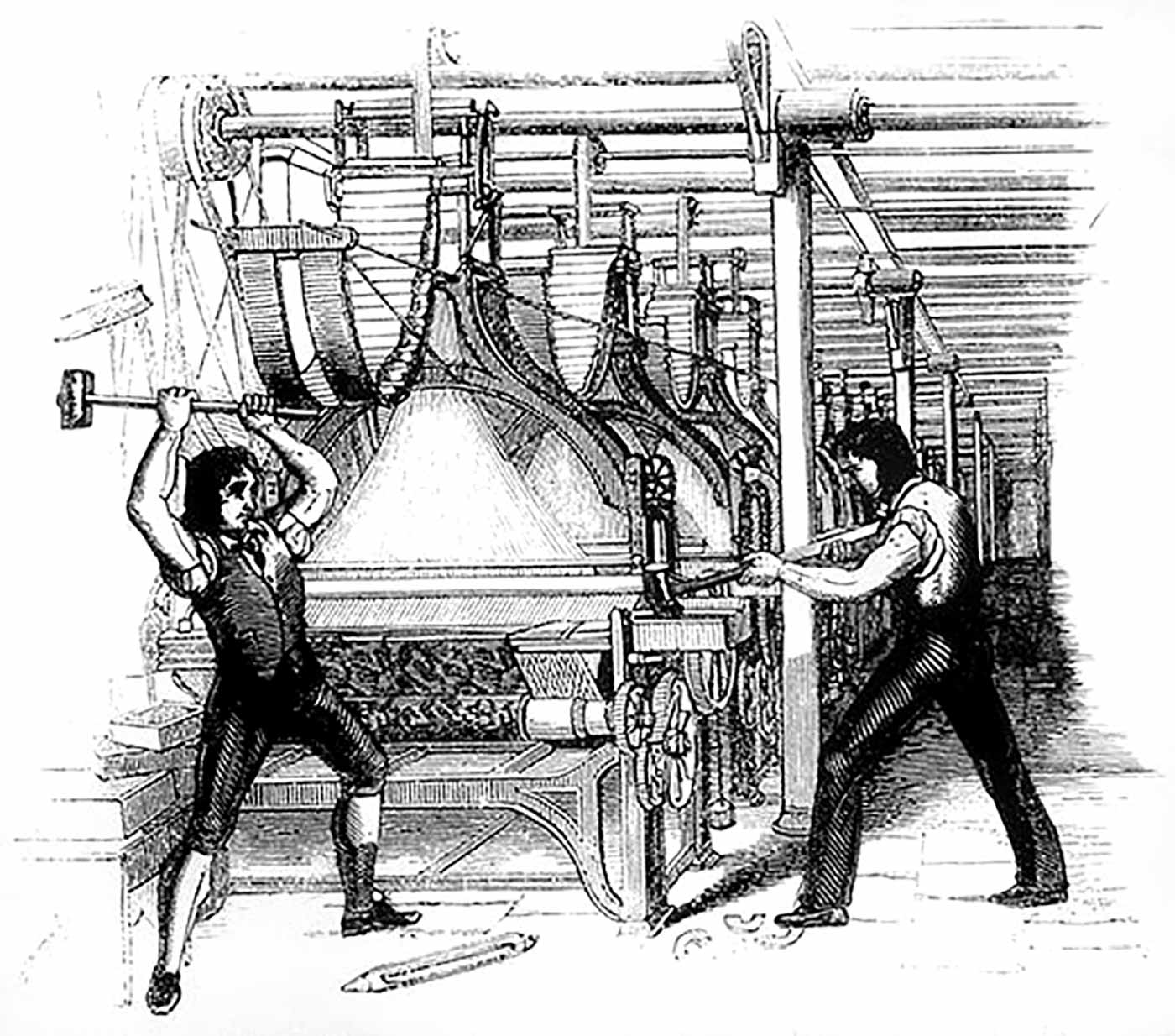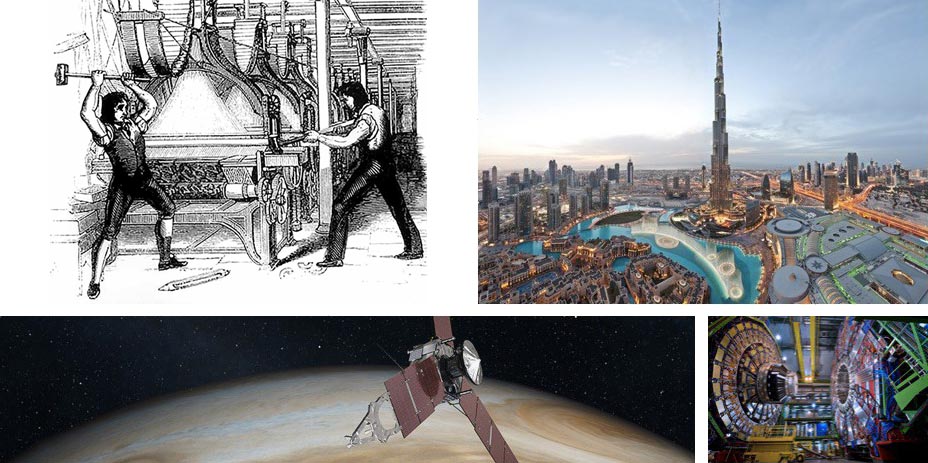Don’t replace people. Augment them.
If we let machines put us out of work, it will be because of a failure of imagination and the will to make a better future.
 Frame-breakers, or Luddites, smashing a loom. (source: Wikimedia Commons)
Frame-breakers, or Luddites, smashing a loom. (source: Wikimedia Commons)
“Could a machine do your job?” ask Michael Chui, James Manyika, and Mehdi Miremadi in a recent McKinsey Quarterly article, “Where Machines Could Replace Humans and Where They Can’t Yet.” The authors try to put the current worries about this question in perspective:
“As automation technologies such as machine learning and robotics play an increasingly great role in everyday life, their potential effect on the workplace has, unsurprisingly, become a major focus of research and public concern. The discussion tends toward a Manichean guessing game: which jobs will or won’t be replaced by machines?
In fact, as our research has begun to show, the story is more nuanced. While automation will eliminate very few occupations entirely in the next decade, it will affect portions of almost all jobs to a greater or lesser degree, depending on the type of work they entail.”
Instead of the binary question of which jobs will be eliminated, the authors instead wisely point out that it is tasks that are being automated, and that automation doesn’t simply destroy jobs. It changes them.
But they don’t go far enough in their analysis. They assess the potential for job change in terms of the technical feasibility of automating various activities, the economics of labor supply and demand, and whether the savings from automation will justify the cost. They also note that: “A fourth factor to consider is the benefits beyond labor substitution, including higher levels of output, better quality, and fewer errors. These are often larger than those of reducing labor costs.”
But they don’t ask what, in my opinion, is the key question.
What will new technology let us do that was previously impossible?

Those weavers who smashed machine looms in Ned Ludd’s rebellion of 1811 didn’t realize that descendants of those machines would make unbelievable things possible. We’d tunnel through mountains and under the sea, we’d fly through the air, crossing continents in hours, we’d build cities in the desert with buildings a half mile high, we’d more than double average human lifespan, we’d put spacecraft in orbit around Jupiter, we’d smash the atom itself! What is impossible today, but will become possible with the technology we are now afraid of?
As Google chief economist Hal Varian has said, “My grandfather wouldn’t recognize what I do as work.” What are the new jobs of the 21st century, jobs that aren’t going to be replaced or changed, but invented out of whole cloth?
Let me explain with a personal anecdote. I used to be legally blind without huge Coke-bottle glasses. My eyes were fixed by an augmented surgeon able to do something that had been previously impossible. Ten years ago, in my column for Make magazine, I gave an account of my surgery:
I had laser eye surgery the other day, and after more than forty years of wearing glasses so strong that I was legally blind without them, I can see clearly on my own. I had a perfect outcome: 20/20 for far vision, yet still able to read and do other close work as well. I keep saying to myself: I’m seeing with my own eyes!
But in order to remove my need for prosthetic vision, the surgeon ended up relying on prosthetics of her own, performing the surgery with the aid of a complex of high tech equipment and a team of specialized technicians.
First they mapped my eyes with a device called a corneal topographer, and came up with a modification plan. Then they used a laser to blister the surface of my cornea, and twenty minutes later, the surgeon used a micro-keratome to lift the flap of the blister so another laser could do the real mods to the deeper layers of the cornea. During the actual surgery, apart from lifting the flap and smoothing it back into place after the laser was done, her job was to clamp open my eyes, hold my head, utter reassuring words, and tell me, sometimes with urgency, to keep looking at the red light! Afterwards, I asked what happened if my eyes drifted, and I didn’t stay focused on the light. “Oh, the laser would stop. It only works when your eyes are tracking.”
In short, surgery this sophisticated could never be done by an unaugmented human being. The human touch of my superb doctor was paired with the inhuman accuracy of complex machines, a twenty-first century hybrid freeing me from the tyranny of assistive devices first invented in thirteenth century Italy.
Whether or not we’re heading for a Kurzweil-style singularity, in which humans merge with machines, an increasing number of our activities are only possible with the aid of computers and other complex devices. My eye surgery is only one example.
The revolution in sensors, computers and control technologies is going to make many of the daily activities of the twentieth century seem quaint as, one by one, they are reinvented in the twenty-first.
This is the true opportunity of technology: it extends human capability. There is way too much handwringing about the possibility of technology eliminating human jobs, and way too little imagining new jobs that could only be done with the help of technology.
There’s a profound failure of imagination and will in much of today’s economy. For every Elon Musk who wants to reinvent the world’s energy infrastructure, build revolutionary new forms of transport, go to Mars, and forge ahead with self-driving cars, there are far too many companies that are simply cutting costs and pulling money out of the economy.
I sometimes think it will take a great crisis to pull us out of our current malaise, in much the same way that World War II helped to end the Great Depression. Climate change or pandemic or another vast war impelled by anger and hopelessness may be the trigger. But one would hope that we could avoid that dire contingency!
Economic historian Louis Hyman was recently interviewed about the Gig economy (one symptom of the technological displacement that Chui, Manyika, and Miremadi explore). Hyman reflected on what the history of the Great Depression and World War II teaches us about the kind of investment that it will take to make a better future.
“There’s a great unraveling, and there’s a great forgetting what made possible the post-war life and forgetting that there’s a deep connection between security in our economic lives, and security and us as a democratic society, as people who are happy, and vote reasonably and don’t, you know, worry about the future as much. Across lines of class, across lines of education, we are all moving towards this freelance economy, this unstable economy. And for some people, it works out great if you’re a consultant. You can make tons of money in just one day. And if you’re an undocumented worker who’s working in very dangerous conditions outside the surveillance of labor law, it’s not so good …
“Back in the 1930s, when there were homeless encampments in Washington, D.C., very much like the homeless encampments that are now under the I-280 in San Francisco, the federal government invested capital in new industries to create jobs for millions of people. They created tax codes that redistributed from the rich to the poor …”
But redistribution of income and the beginnings of the modern social safety net were only part of the story. Hyman continued:
“The New Deal’s Reconstruction Finance Corporation not only helped light up America — moving it from 10 percent of homes having electricity in 1930 to more than 60 percent a decade later — it also funded research in the Defense Plant Corporation.
“‘It was fundamentally about investment in edgy technology, so things like aerospace, aluminum extraction, synthetic rubber were all brought to scale,’ Hyman says. ‘Aerospace before 1939 had fewer people working in it than worked in candy manufacturing. And after World War II, the aerospace industry was four times the size of the pre-war car industry. This is incredible scale and scope of an endeavor, to utterly transform the economy in about five years, by using idle capital….’
“‘There’s so much capital out there, and they don’t know where to put it. It’s hard for us to imagine as normal people, but for the big players in the global economy, the pension funds, the hedge funds, the bazillion billionaires, they’re desperate to find an outlet for capital. And right now, the best outlook for capital is our home mortgages and our credit card loans. And until we provide them with better outlets, like we did during the 1930s and ’40s, to invest in aerospace and more cutting edge technology in industries that employ millions, it’s going be very hard to get our economy going again. And fundamentally, this is how capitalism has to work. It has to be a virtuous cycle, where capital comes into businesses, is invested and creates new jobs.’”
Hyman’s reminder that during World War II we utterly transformed the US economy during a period of only five years should inspire us to ask what is holding us back today. Do we need a crisis, or can we make bold moves without one?
How we frame the future matters! If we create an attitude of fear towards technology, we miss the huge opportunity to put it to work solving problems that bedevil us today. It’s our responsibility as entrepreneurs and technologists to rethink what is possible!
Technology lets us rethink the very structure of how we do things. Consider, for example, the way that Uber and Lyft have transformed urban transportation. There were connected taxicabs long before Uber — but all they did was to recreate the old process. What we got for our connectivity was a credit card reader in the back, and a small screen showing us ads. What Garrett Camp and Travis Kalanick realized was that humans were now augmented by location-aware smartphones, and so you could completely rethink the way you summoned a car. It would be utter magic to someone from the past — that you can click on your phone, and summon a car to where-ever you are, and to know just how long it will take for a car to pick you up.
But when Uber started talking about self driving cars, they lost the plot and started talking only about cutting costs and eliminating workers. Rather than crowing about how they’d finally get rid of those pesky drivers, they should have been talking about an experiment that they’ve run since 2014, delivering flu shots. “Sure, we won’t always have drivers. But just imagine how many other jobs we can restructure and make more magical and on demand once the transportation is even cheaper and more convenient!”
Zipline is completely rethinking how healthcare could be delivered in an on-demand world. Their pilot project in Rwanda looks to address one of the leading causes of death — postpartum hemorrhage — by delivering blood on demand, via high speed drone, to locations without modern transportation or healthcare infrastructure. But if you think about it, on demand technology could be transforming healthcare everywhere — if we think big, and use technology not just to cut costs and improve profits but to deliver previously impossible services!
If you’d told the weavers of Ned Ludd’s time that those machines they were smashing would mean that ordinary people would have more changes of clothing than the richest nobles of their day, they would have shaken their heads in astonishment.
What might we be astonished by if we have the courage to invest in the possibilities of a better future?
